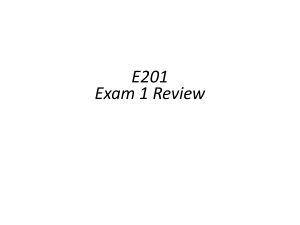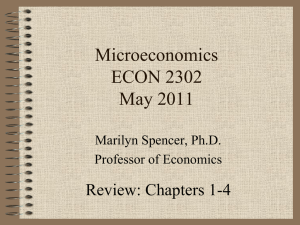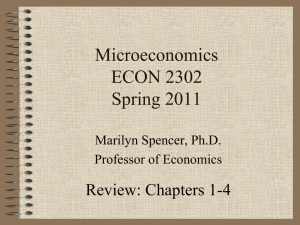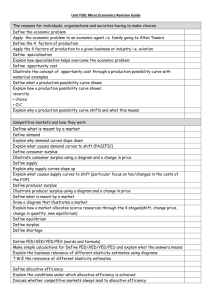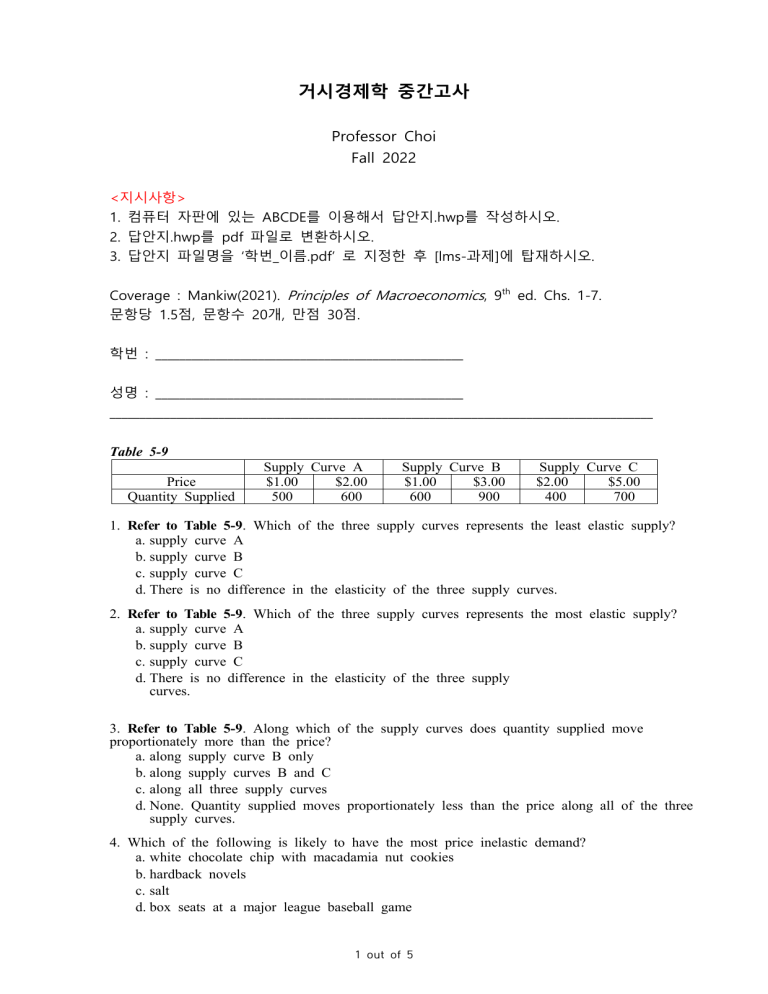
거시경제학 중간고사 Professor Choi Fall 2022 <지시사항> 1. 컴퓨터 자판에 있는 ABCDE를 이용해서 답안지.hwp를 작성하시오. 2. 답안지.hwp를 pdf 파일로 변환하시오. 3. 답안지 파일명을 ‘학번_이름.pdf’ 로 지정한 후 [lms-과제]에 탑재하시오. Coverage : Mankiw(2021). Principles of Macroeconomics, 9th ed. Chs. 1-7. 문항당 1.5점, 문항수 20개, 만점 30점. 학번 : ___________________________________________________ 성명 : ___________________________________________________ __________________________________________________________________________________________ Table 5-9 Price Quantity Supplied Supply Curve A $1.00 $2.00 500 600 Supply Curve B $1.00 $3.00 600 900 Supply Curve C $2.00 $5.00 400 700 1. Refer to Table 5-9. Which of the three supply curves represents the least elastic supply? a. supply curve A b. supply curve B c. supply curve C d. There is no difference in the elasticity of the three supply curves. 2. Refer to Table 5-9. Which of the three supply curves represents the most elastic supply? a. supply curve A b. supply curve B c. supply curve C d. There is no difference in the elasticity of the three supply curves. 3. Refer to Table 5-9. Along which of the supply curves does quantity supplied move proportionately more than the price? a. along supply curve B only b. along supply curves B and C c. along all three supply curves d. None. Quantity supplied moves proportionately less than the price along all of the three supply curves. 4. Which of the following is likely to have the most price inelastic demand? a. white chocolate chip with macadamia nut cookies b. hardback novels c. salt d. box seats at a major league baseball game 1 out of 5 5. Which of the following is likely to have the most price inelastic demand? a. tablet computers b. leather boots c. lightbulbs d. optional textbooks 6. Which of the following expressions is valid for the price elasticity of demand? a. Price elasticity of demand = . Price elasticity of demand = . Price elasticity of demand = . Price elasticity of demand = . b. c. d. 7. Nick and Traci are two woodworkers who both make tables and chairs. In one month, Nick can make 3 tables or 6 chairs, whereas Traci can make 16 tables or 48 chairs. Given this, we know that the opportunity cost of 1 chair is a. 1/2 table for Nick and 1/3 table for Traci. b. 1/2 table for Nick and 3 tables for Traci. c. 3 tables for Nick and 1/2 table for Traci. d. 1/3 table for Nick and 2 tables for Traci. 8. You lose your job and, as a result, you buy fewer iTunes music downloads. This shows that you consider iTunes music downloads to be a. a substitute good. b. an inferior good. c. a normal good. d. a complementary good. 9. Suppose scientists provide evidence that people who drink energy drinks are more likely to have a heart attack than people who do not drink energy drinks. We would expect to see a. no change in the demand for energy drinks. b. a decrease in the demand for energy drinks. c. an increase in the demand for energy drinks. d. a decrease in the supply of energy drinks. 10. Suppose the government wants to encourage Americans to exercise more, so it imposes a binding price ceiling on the market for in-home treadmills. As a result, a. the demand for treadmills will increase. b. the supply of treadmills will decrease. c. a shortage of treadmills will develop. d. a surplus of treadmills will develop. 11. There are very few, if any, good substitutes for automotive tires. Therefore, the demand for automotive tires would tend to be a. elastic. b. unit elastic. c. inelastic. d. highly responsive to changes in income as well as changes in prices. 2 out of 5 Figure 6-5 12. Refer to a. When b. When c. When d. When Figure 6-5. the price is the price is the price is the price is Which of the following statements is not correct? $10, quantity supplied equals quantity demanded. $6, there is a surplus of 8 units. $12, there is a surplus of 4 units. $16, quantity supplied exceeds quantity demanded by 12 units. 13. Refer to Figure 6-5. A government-imposed price of $12 in this market is an example of a a. binding price ceiling that creates a shortage. b. nonbinding price ceiling that creates a shortage. c. binding price floor that creates a surplus. d. nonbinding price floor that creates a surplus. Figure 7-1 3 out of 5 14. Refer to Figure 7-1. When the price is P1, consumer surplus is a. A. b. A+B. c. A+B+C. d. A+B+D. Figure 7-18 rd 15. Refer to Figure 7-18. Suppose the willingness to pay of the marginal buyer of the 3 unit is $125. Then total surplus is maximized if a. 1 unit of the good is produced and sold. b. 2 units of the good are produced and sold. c. 3 units of the good are produced and sold. d. 4 units of the good are produced and sold. 16. Refer to Figure 7-18. If total a. $100, then the price of the b. $130, then the price of the c. $160, then the price of the d. $120, then the price of the surplus is $240 and consumer surplus is good is $130. good is $120. good is $100. good is $90. 4 out of 5 Table 7-1 Buyer Calvin Sam Andrew Lori Willingness To Pay $150.00 $135.00 $120.00 $100.00 17. Refer to Table 7-1. If the price of the product is $130, then who would be willing to purchase the product? a. Calvin b. Calvin and Sam c. Calvin, Sam, and Andrew d. Calvin, Sam, Andrew, and Lori Figure 6-18 The vertical distance between points A and B represents the tax in the market. 18. Refer to Figure 6-18. The price that buyers pay after the tax is imposed is a. $8. b. $10. c. $16. d. $24. 19. Refer to Figure 6-18. The effective price that sellers receive after the tax is imposed is a. $6. b. $10. c. $16. d. $24. 20. Refer to Figure 6-18. The amount of the tax per unit is a. $6. b. $8. c. $14. d. $18. <The End> 5 out of 5
